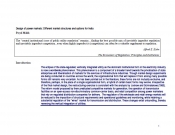Design of Power markets : Different market structures and proposed options for India
Payal Malik
May 2004
The eclipse of the state-regulated, vertically integrated utility as the dominant institutional form in the electricity industry is now a worldwide phenomenon. This phenomenon is a component of a broader trend towards the privatization of state enterprises and liberalization of markets for the services of infrastructure industries. Though market design experiments are being conducted in countries across the world, the organizational form that will replace it from among many possible forms still remains very uncertain. As has been pointed out in the literature, these forms are mutually exclusive, and therefore, perhaps, in the place of a single organizational form, a hybrid of certain basic forms may evolve. Irrespective of the final market design, the restructuring exercise is consistent with the analysis by Joskow and Schmalansee (1983). The reform model proposed by them predicated competitive markets for generation, the operation of transmission facilities on an open-access non-discriminatory common-carrier basis, and retail competition among power marketers that rely on regulated distribution companies for delivery. The regulation of the wholesale and retail energy markets will be reduced to the imposition of structural requirements and operational guidelines and monitoring, while retaining a substantial regulation of the “wires” market for transmission and distribution. These changes entail unbundling, thereby reversing the vertical integration of utilities.
States, Sectors, Surveys, and Impact Evaluation







